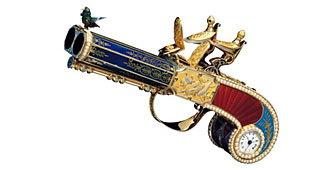A trip through time with Patek Philippe

Luxury watchmaker Patek Philippe has opened a new museum in Geneva housing one of the world's finest collections of timepieces.
The 2,000 watches, clocks and enamels on show – each exceptional in their own right – are from the private collection of the Patek Philippe president, Philippe Stern. Observers say the size and breadth of the collection – amassed over the course of several decades – took many by surprise.
Stern says his museum is primarily a tribute to the art of watchmaking, rather than a celebration of man’s attempts to measure time, a task that other Swiss museums have undertaken successfully.
The fact that, in the same week the museum opened to the public, a Patek Philippe wristwatch was sold at auction for a world record price of over SFr 3 million is a reminder of the enduring appeal of this exclusive brand: among the watches in the museum are some owned by the likes of Queen Victoria, Tsar Nicolas II, Tolstoy, Albert Einstein and Rudyard Kipling.
Promotional tool
The museum, which covers some 2,000 square metres on four floors, is likely to be a powerful promotional tool for the Patek Philippe brand.
Even the building that houses the museum – in the Plainpalais district – has something to tell us about the company, and of the history of watchmaking in Geneva. Built in 1920, it was a jeweller’s workshop before becoming one of Patek Philippe’s main factories.
When the company decided to relocate to new premises in the city, the empty building was considered to be the ideal location for the museum, a long-cherished project of Stern’s.
What is fascinating for locals is the development of the industry in Geneva. The city began to be associated with watchmaking, enamelling and jewellery from the late 16th century, when Huguenot refugees fled French persecution and brought their skills with them.
By the 17th century Geneva was also the capital of miniature painting on enamel, and there are dozens of excellent examples in the museum.
Changing fashions
The Stern collection is split into two sections. One catalogues Patek Philippe watches, from the creation of the company in 1839 by the Polish refugee, Antoine Norbert de Patek, through the changing fashions and technological advances of the 19th and 20th centuries to the present day.
The second section is dedicated to rare timepieces of European – and mostly Genevan – provenance that pre-date the arrival of Patek Philippe on the watchmaking scene. Among them, a number of rare Breguets and a ancient German drum watch from the early-16th century.
Calibre 89
The collection of Patek Philippe watches is notable for the technical innovations the company has been responsible for, but also for its aesthetic quality. The watches are a combination of art, precision science and craftsmanship.
Among the many highlights is the prototype of the Calibre 89, the most complicated watch ever produced. But also eye-catching are the large number of watches created specifically for the Chinese market.
For the first six months, the museum will be exhibiting a number of timepieces lent by private collectors. These include the most expensive watch ever sold – a 1925 Patek Philippe pocket watch with a bewildering number of complications, sold at auction in 1999 for $ 11 million.
Patek Philippe claims to be the only local manufacturer that has been active in Geneva for more than 160 years without interruption, and is therefore best placed to tell the story of the city’s watchmaking accomplishments.
The museum also features an extensive library containing over 4,000 books, all devoted exclusively to the art of timekeeping. There is also an exhibition of old machines and tools that bear testimony to the progress made in precision engineering.
Patek Philippe says the aim of the museum is not to compete with the city’s publicly-funded Museum of Watchmaking and Enamelling. It says the two establishments can complement each other.
by Roy Probert

In compliance with the JTI standards
More: SWI swissinfo.ch certified by the Journalism Trust Initiative
You can find an overview of ongoing debates with our journalists here . Please join us!
If you want to start a conversation about a topic raised in this article or want to report factual errors, email us at english@swissinfo.ch.